Reading
The meeting that led to the formation of Reading FC was held in the Bridge Street Rooms under the chairmanship of one JE Sydenham, who became the club's first Honorary Secretary. Their first colours were navy and white hooped jerseys.
The club competed in the FA Cup from 1878 onwards and became founder members of the Southern League in 1894. A year later Reading FC turned professional.
The team wore navy and white stripes and in the seasons leading up to the First World War, a mixture of collars was evident and the stripes were centred in both white and navy, giving pre-war teams a rather motley appearance, although was far from unusual at the time.
Reading's career in the Southern League was undistinguished but they did win the Second Division in 1911 and held on to their place until the outbreak of the First World War. As a result, Reading were one of the clubs chosen en bloc to form the new Third Division of the Football League in 1920. In 1926 the team won the Third Division (South) championship and took their place in Division Two. The following season they reached the FA Cup semi-final, losing to Cardiff City who went on to win the competition. Reading's glory was, however, short lived and in 1931 they were relegated.
For the next 27 years Reading would languish in Division Three (South). When the regional divisions were scrapped in 1958, Reading were placed in Division Three and remained there until being relegated to Division 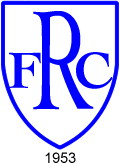 Four in 1971. The old dark blue and white stripes were replaced by royal blue and white hoops immediately before the Second World War, with the broader hoops that were to become associated with the club first appearing in 1948. Plain white shirts were adopted for a while in the 1950s, initially in the shiny artificial fabric that enjoyed a brief vogue at the time. Reading's first recorded crest worn appeared on these shirts - a simple letter "R" on a shield, worn just for one season.
Four in 1971. The old dark blue and white stripes were replaced by royal blue and white hoops immediately before the Second World War, with the broader hoops that were to become associated with the club first appearing in 1948. Plain white shirts were adopted for a while in the 1950s, initially in the shiny artificial fabric that enjoyed a brief vogue at the time. Reading's first recorded crest worn appeared on these shirts - a simple letter "R" on a shield, worn just for one season.
An all sky-blue strip appeared in the 1960s, following the success of Coventry City who made a similar change.
In 1969 manager Jack Mansell ordered a return to the traditional blue and white hoops but in 1971, the club's centenary season, the "Royals" were relegated to Division Four. In 1976 they won promotion only to drop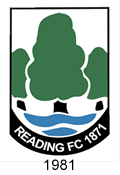 back again the following seasons. In 1979, Reading won the Fourth Division championship for the first time.
back again the following seasons. In 1979, Reading won the Fourth Division championship for the first time.
In 1981 a new crest appeared that featured three elm trees, a reference to Reading's Elm Park ground. This was dropped when the Royals adopted a new colour scheme in 1983.
The season of 1982-83 almost saw Reading go out of business. Relegated back to Division Four and facing a financial crisis, plans were made to sell off Elm Park and merge the club with Robert Maxwell's Oxford United to form a new club to be known as Thames Valley Royals. These threats were warded off and with former player, 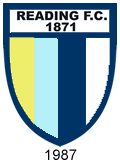 Roger Smee installed as chairman, a new manager and new colours of sky blue, dark blue, yellow and white, the Royals won promotion in 1984. Two seasons later, in 1986, the club won the Third Division title and returned to Division Two after an absence of 55 years. A new crest, a simple presentation of the colours of the time, was adopted in 1987.
Roger Smee installed as chairman, a new manager and new colours of sky blue, dark blue, yellow and white, the Royals won promotion in 1984. Two seasons later, in 1986, the club won the Third Division title and returned to Division Two after an absence of 55 years. A new crest, a simple presentation of the colours of the time, was adopted in 1987.
Once again the club's success was short lived and after two seasons Reading were relegated. In 1990, the club was bought by John Madejski who injected a new sense of ambition. The hooped shirts were restored in 1992, partly due to pressure from supporters and in 1994 the "Biscuitmen" (a rather whimsical reference to one of the town's traditional industries) won promotion to Nationwide Division One (formerly Division Two) and then a place in the play-offs in 1995 after finishing in second place. Because of 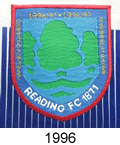 the reduction in the size of the Premier League, only two promotion places were available: in any other season Reading would have won automatic promotion to the top flight.
the reduction in the size of the Premier League, only two promotion places were available: in any other season Reading would have won automatic promotion to the top flight.
Between 1996 and 1998, the old elm crest was revived. The significance was twofold: 1996 marked the centenary of Reading's Elm Park while 1998-99 would be the season that they would move into a new home.
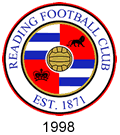 In 1998 Reading were relegated to Nationwide Division Two, a misfortune offset by the move into the brand new Madejski Stadium in 1999. This fresh start was marked by the introduction of a brand new club badge that featured the club's iconic blue and white hoops, a crown representing Berkshire's status (Windsor Castle is in the county which is often referred to as "Royal Berkshire") and the Maiwand Lion, a prominent local landmark.
In 1998 Reading were relegated to Nationwide Division Two, a misfortune offset by the move into the brand new Madejski Stadium in 1999. This fresh start was marked by the introduction of a brand new club badge that featured the club's iconic blue and white hoops, a crown representing Berkshire's status (Windsor Castle is in the county which is often referred to as "Royal Berkshire") and the Maiwand Lion, a prominent local landmark.
In 2002, the club returned to Nationwide Division One and the following season once again qualified for the play offs. Steady consolidation was rewarded when, in 2006, the club ran away with the Coca Cola Championship title to take their place in the Premiership, the first time Reading had played in the top level.
